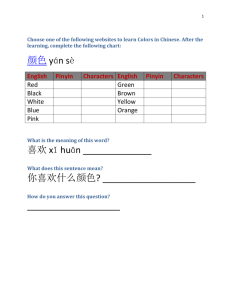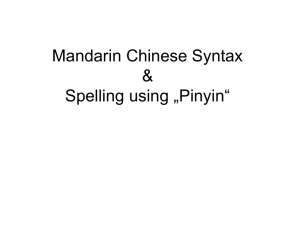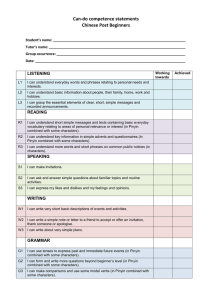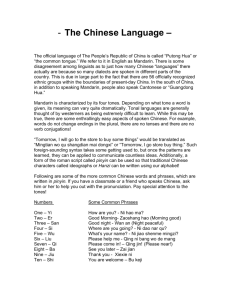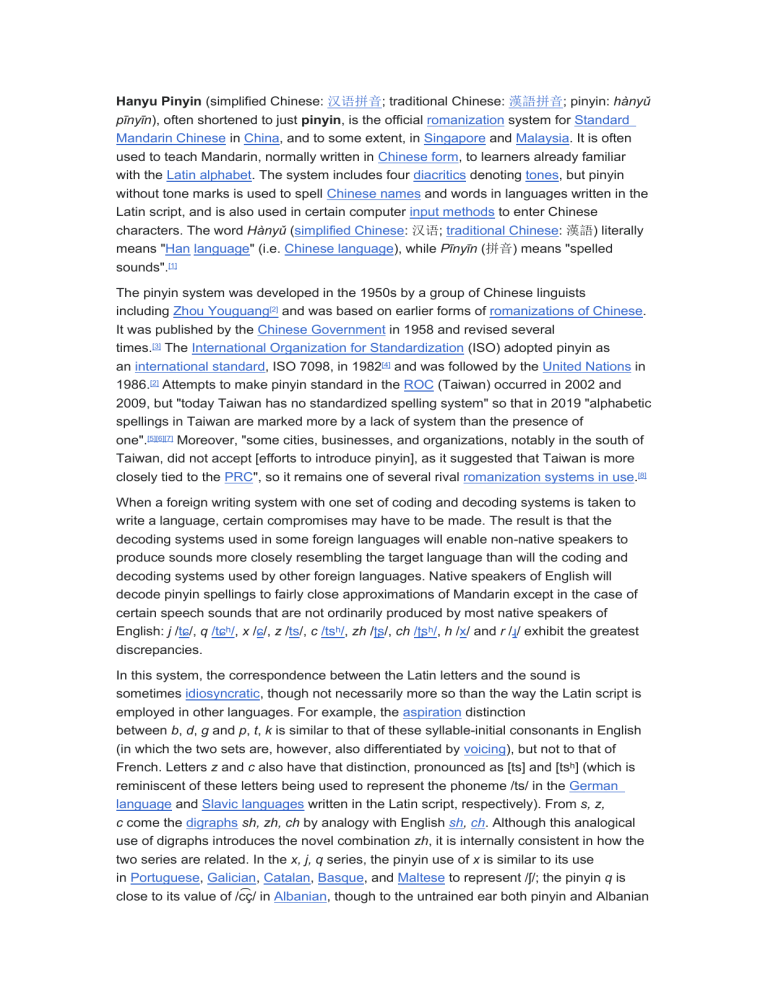
Hanyu Pinyin (simplified Chinese: 汉语拼音; traditional Chinese: 漢語拼音; pinyin: hànyǔ
pīnyīn), often shortened to just pinyin, is the official romanization system for Standard
Mandarin Chinese in China, and to some extent, in Singapore and Malaysia. It is often
used to teach Mandarin, normally written in Chinese form, to learners already familiar
with the Latin alphabet. The system includes four diacritics denoting tones, but pinyin
without tone marks is used to spell Chinese names and words in languages written in the
Latin script, and is also used in certain computer input methods to enter Chinese
characters. The word Hànyǔ (simplified Chinese: 汉语; traditional Chinese: 漢語) literally
means "Han language" (i.e. Chinese language), while Pīnyīn (拼音) means "spelled
sounds".[1]
The pinyin system was developed in the 1950s by a group of Chinese linguists
including Zhou Youguang[2] and was based on earlier forms of romanizations of Chinese.
It was published by the Chinese Government in 1958 and revised several
times.[3] The International Organization for Standardization (ISO) adopted pinyin as
an international standard, ISO 7098, in 1982[4] and was followed by the United Nations in
1986.[2] Attempts to make pinyin standard in the ROC (Taiwan) occurred in 2002 and
2009, but "today Taiwan has no standardized spelling system" so that in 2019 "alphabetic
spellings in Taiwan are marked more by a lack of system than the presence of
one".[5][6][7] Moreover, "some cities, businesses, and organizations, notably in the south of
Taiwan, did not accept [efforts to introduce pinyin], as it suggested that Taiwan is more
closely tied to the PRC", so it remains one of several rival romanization systems in use.[8]
When a foreign writing system with one set of coding and decoding systems is taken to
write a language, certain compromises may have to be made. The result is that the
decoding systems used in some foreign languages will enable non-native speakers to
produce sounds more closely resembling the target language than will the coding and
decoding systems used by other foreign languages. Native speakers of English will
decode pinyin spellings to fairly close approximations of Mandarin except in the case of
certain speech sounds that are not ordinarily produced by most native speakers of
English: j /tɕ/, q /tɕʰ/, x /ɕ/, z /ts/, c /tsʰ/, zh /ʈʂ/, ch /ʈʂʰ/, h /x/ and r /ɻ/ exhibit the greatest
discrepancies.
In this system, the correspondence between the Latin letters and the sound is
sometimes idiosyncratic, though not necessarily more so than the way the Latin script is
employed in other languages. For example, the aspiration distinction
between b, d, g and p, t, k is similar to that of these syllable-initial consonants in English
(in which the two sets are, however, also differentiated by voicing), but not to that of
French. Letters z and c also have that distinction, pronounced as [ts] and [tsʰ] (which is
reminiscent of these letters being used to represent the phoneme /ts/ in the German
language and Slavic languages written in the Latin script, respectively). From s, z,
c come the digraphs sh, zh, ch by analogy with English sh, ch. Although this analogical
use of digraphs introduces the novel combination zh, it is internally consistent in how the
two series are related. In the x, j, q series, the pinyin use of x is similar to its use
in Portuguese, Galician, Catalan, Basque, and Maltese to represent /ʃ/; the pinyin q is
close to its value of /c͡ç/ in Albanian, though to the untrained ear both pinyin and Albanian
pronunciations may sound similar to the ch. Pinyin vowels are pronounced in a similar
way to vowels in Romance languages.
The pronunciations and spellings of Chinese words are generally given in terms
of initials and finals, which represent the language’s segmental phonemic portion, rather
than letter by letter. Initials are initial consonants, whereas finals are all possible
combinations of medials (semivowels coming before the vowel), a nucleus vowel,
and coda (final vowel or consonant).

